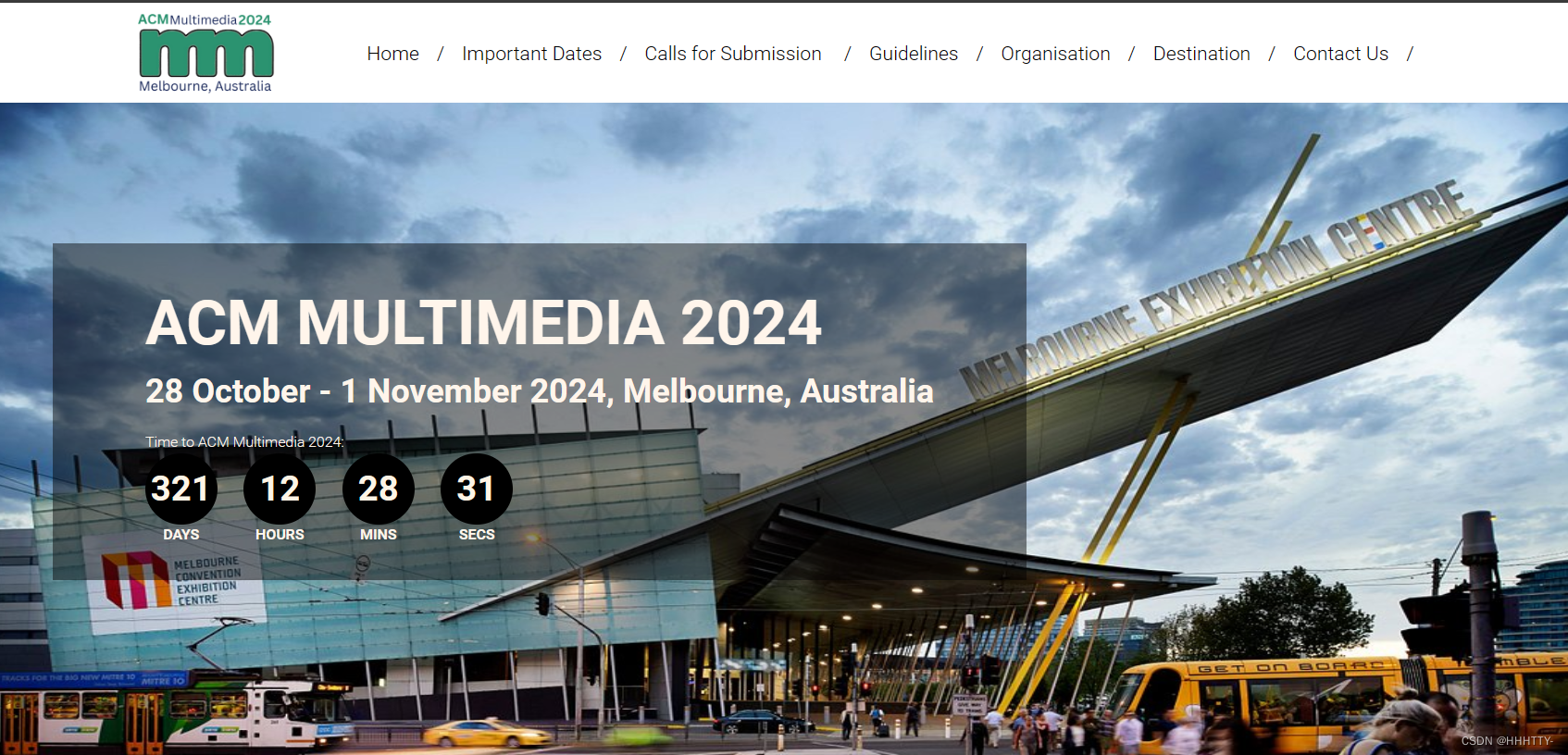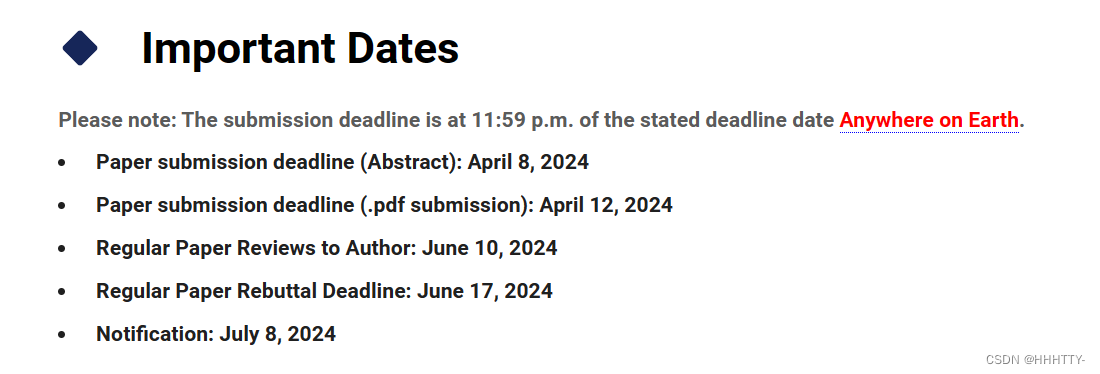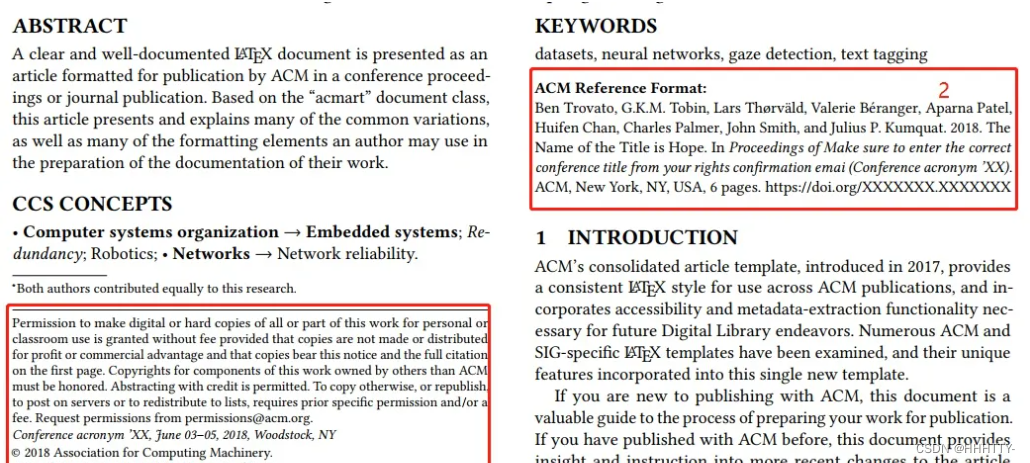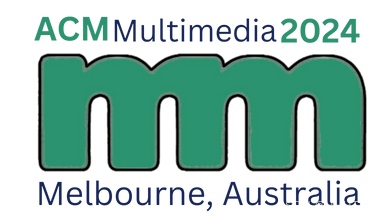ACMMM 2024 ACM International Conference on Multimedia

目录
- 0、 重要
- 0.1 官网:
- 0.2 提交 (OpenReview)
- 1、 Important Dates
- 2、 Theme
- 2.1 Theme: Engaging Users with Multimedia
- 2.2 Theme: Experience
- 2.3 Theme: Multimedia Systems
- 2.4 Theme: Multimedia Content Understanding and Generation
- 3、 ACM MM 投稿论文模板
- 3.1 下载地址
- 3.2 选择模板
- 3.3 修改模板
- 3.4 微调
0、 重要
0.1 官网:
- https://2024.acmmm.org/ 链接
0.2 提交 (OpenReview)
https://openreview.net/group?id=acmmm.org/ACMMM/2024/Conference#tab-recent-activity 链接
- Submission Start: Mar 01 2024 UTC-0,
- Abstract Registration: Apr 08 2024 11:59PM UTC-0,
- Submission Deadline: Apr 12 2024 11:59PM UTC-0

1、 Important Dates
Please note: The submission deadline is at 11:59 p.m. (Anywhere on Earth) of the stated deadline date.
- Regular Papers Submission (Abstract) April 8, 2024
- Regular Papers Submission April 12, 2024
- Regular paper supplementary April 19, 2024
- Brave New Ideas SubmissionJune 3, 2024
- Open Source Competition SubmissionJune 3, 2024
- Panel Proposals SubmissionJune 3, 2024
- Tutorial Proposals SubmissionJune 3, 2024
- Doctoral Symposium SubmissionJune 3, 2024
- Technical Demo and Video Program SubmissionJune 3, 2024
- Reproducibility Companion PaperJune 3, 2024
- Regular Paper Reviews to Author June 10, 2024
- Regular Paper Rebuttal Deadline June 17, 2024
- Regular Paper Notification July 8, 2024
请注意:提交截止时间为所述截止日期的当天地球任何地方时间的晚上11:59。
- 普通论文提交(摘要) 截止日期为2024年4月8日。
- 普通论文提交 截止日期为2024年4月12日。
- 普通论文 补充资料 截止日期为2024年4月19日。
- Brave New Ideas 提交截止日期为2024年6月3日。
- 开源竞赛提交截止日期为2024年6月3日。
- 小组讨论提案提交截止日期为2024年6月3日。
- 教程提案提交截止日期为2024年6月3日。
- 博士生研讨会提交截止日期为2024年6月3日。
- 技术演示和视频节目提交截止日期为2024年6月3日。
- 可再现性伴随论文提交截止日期为2024年6月3日。
- 普通论文 评审 发送给作者 截止日期为2024年6月10日。
- 普通论文 答辩 截止日期 为2024年6月17日。
- 普通论文 通知 日期为2024年7月8日。

2、 Theme
2.1 Theme: Engaging Users with Multimedia
The engagement of multimedia with society as a whole requires research that addresses how multimedia can be used to connect people with multimedia artifacts that meet their needs in a variety of contexts. The topic areas included under this theme include:
- Emotional and Social Signals
This area focuses on the analysis of emotional, cognitive (e.g., brain-based) and interactive social behavior in the spectrum of individual to small group settings. It calls for novel contributions with a strong human-centered focus specializing in supporting or developing automated techniques for analyzing, processing, interpreting, synthesizing, or exploiting human social, affective and cognitive signals for multimedia applications.)
- Multimedia Search and Recommendation
To engage user in information access, search and recommendation requires not only understanding of data but also user and context. This area calls for novel solutions for user-centric multimedia search and recommendations, in either automatic or interactive mode, with topics ranging from optimization, user intent prediction, to personalized, collaborative or exploratory algorithms. (Note: Topics focusing primarily on indexing and scalability should be submitted to “Multimedia systems: Data Systems indexing and management”)
- Summarization, Analytics, and Storytelling
The information underlying multimedia is by nature multi-perspective. Allowing efficient multi-perspective and context-adaptive information access remains an open problem. This area calls for new and novel solutions that can compose, link, edit and summarize multimedia data into a compact but insightful, enjoyable and multi-perspective presentation to facilitate tasks such as multimedia analytics, decision making, searching and browsing.
多媒体与整个社会的互动需要研究如何利用多媒体来连接人们与满足其需求的多媒体作品,以适应各种环境下的需求。在这个主题下包括的议题领域有:
- 情感和社交信号
这个领域着重于对情感、认知(例如基于大脑的)和互动社交行为在个体到小团体环境中的分析。它呼吁对具有强烈以人为中心关注的新颖贡献,专注于支持或开发自动化技术,用于分析、处理、解释、合成或利用人类社交、情感和认知信号,以应用于多媒体领域。
- 多媒体搜索与推荐
为了让用户参与信息访问、搜索和推荐,不仅需要理解数据,还需要了解用户和环境。这个领域呼吁提出面向用户的多媒体搜索和推荐的新颖解决方案,无论是自动还是交互模式,涉及的话题包括优化、用户意图预测,以及个性化、协作或探索算法。(注:主要关注索引和可扩展性的话题应提交给“多媒体系统:数据系统索引和管理”)
- 摘要、分析和叙事
支持多角度信息访问和上下文自适应仍然是一个待解决的问题,多媒体背后的信息是多视角的。这个领域呼吁提出新的、创新的解决方案,能够将多媒体数据组合、链接、编辑和总结成简洁但富有见地、愉悦且多视角的呈现形式,以促进多媒体分析、决策制定、搜索和浏览等任务。
2.2 Theme: Experience
One of the core tenants of our research community is that multimedia contributes to the user experience in a rich and meaningful manner. The topics organized under this theme are concerned with innovative uses of multimedia to enhance the user experience, how this experience is manifested in specific domains, and metrics for qualitatively and quantitatively measuring that experience in useful and meaningful ways. Specific topic areas addressed this year include:
- Interactions and Quality of Experience
Papers under this topic area should address human-centered issues. Topics include (i) novel interaction techniques and modalities for accessing, authoring, and consuming multimedia data, (ii) design and implementation of novel interactive media (iii) new methodologies, models, and metrics to understand and/or measure multimedia quality of experience.
- Art and Culture
Papers under this topic area should develop techniques that enable effective engagement of the public with art and other forms of cultural expression, balancing between sophisticated computational/engineering techniques and artistic / cultural purposes. Topics include (i) digital artworks, including hybrid physical digital installations; dynamic, generative, and interactive multimedia artworks; (ii) computational tools to support creativity, cultural preservation, and curation.
- Multimedia Applications
Papers under this topic area should push the envelope of how multimedia can be used to improve the user experience in a rich and meaningful manner. We solicit papers that design, implement, and evaluate applications that employ multimedia data in surprising new ways or in application scenarios that user experience remains challenging based on today’s start-of-the-art, such as immersive telepresence, distance education.
我们研究社区的核心原则之一是多媒体以丰富而有意义的方式为用户体验做出贡献。在这个主题下组织的议题关注于创新地利用多媒体来增强用户体验,以及这种体验如何在特定领域中体现,以及用于以有用和有意义方式定性和定量测量该体验的指标。今年具体涉及的主题领域包括:
- 交互和体验质量
该主题下的论文应涉及以人为中心的问题。话题包括(i)用于访问、创作和消费多媒体数据的新颖交互技术和模式,(ii)设计和实施新颖的互动媒体,(iii)理解和/或衡量多媒体体验质量的新方法、模型和度量标准。
- 艺术与文化
该主题下的论文应开发出能够有效促进公众与艺术和其他形式的文化表达相互联系的技术,平衡精密的计算/工程技术与艺术/文化目的之间的关系。话题包括(i)数字艺术作品,包括混合物理数字装置;动态、生成和互动式多媒体艺术作品;(ii)支持创意、文化保护和策展的计算工具。
- 多媒体应用
该主题下的论文应推动多媒体如何以丰富而有意义的方式改善用户体验的发展。我们征求那些设计、实施和评估应用程序的论文,这些应用程序以出人意料的新方式使用多媒体数据,或者在今天的技术水平下,例如沉浸式远程存在、远程教育等应用场景中用户体验仍然具有挑战性。
2.3 Theme: Multimedia Systems
Research in multimedia systems is generally concerned with understanding fundamental trade-offs between competing resource requirements, developing practical techniques and heuristics for realizing complex optimization and allocation strategies, and demonstrating innovative mechanisms and frameworks for building large-scale multimedia applications. Within this theme, we have focused on three target topic areas:
- Systems and Middleware
This area seeks novel contributions that address performance issues in one of the systems components. Topics include operating systems, mobile systems, storage systems, distributed systems, programming systems and abstractions, and embedded systems. Papers must establish performance improvement or non-trivial trade-offs through integration of multiple systems components or enhancing one of the system components.
- Transport and Delivery
Papers under this topic area should address improvement to multimedia transport and delivery mechanisms over a computer network. Topics include network protocol enhancement, supporting multimedia data with network mechanisms such as SDN and NFV, in-network content placement.
- Data Systems Management and Indexing
Papers under this topic area should address performance issues related to data management and indexing to support multimedia access at a large scale, including browsing, searching, recommendation, analysis, processing, and mining. Topics include scalable systems and indexing techniques that support multimedia access and analytics.
多媒体系统的研究通常关注于理解竞争资源需求之间的基本权衡,开发实用的技术和启发式方法来实现复杂的优化和分配策略,并展示用于构建大规模多媒体应用的创新机制和框架。在这个主题下,我们专注于三个目标议题领域:
- 系统与中间件
这个领域寻求解决系统组件性能问题的新颖贡献。话题包括操作系统、移动系统、存储系统、分布式系统、编程系统和抽象、嵌入式系统。论文必须通过整合多个系统组件或增强其中一个系统组件来建立性能改进或非平凡的权衡。
- 传输与传送
该领域的论文应关注在计算机网络上改进多媒体传输和传递机制。话题包括网络协议增强、通过SDN和NFV等网络机制支持多媒体数据、网络中内容放置等。
- 数据系统管理与索引
该领域的论文应解决与数据管理和索引相关的性能问题,以支持大规模的多媒体访问,包括浏览、搜索、推荐、分析、处理和挖掘。话题包括支持多媒体访问和分析的可扩展系统和索引技术。
2.4 Theme: Multimedia Content Understanding and Generation
Multimedia data types by their very nature are complex and often involve intertwined instances of different kinds of information. We can leverage this multi-modal perspective in order to extract meaning and understanding of the world, often with surprising results. Specific topics addressed this year include:
- Multimodal Fusion and Embeddings
In the real world, some problems are addressable only through a combination of multiple media and/or modalities. This area seeks new insights and solutions of how multi-perspective media information should be fused and embedded for novel problems as well as innovative systems.
- Vision and Language
Recent researchs have driven the merging of vision and language in different ways, for example, captioning, question-answering, multi-modal chatbots. This area seeks new solutions and results that are specific to the problems of combining or bridging vision and language.
- Multimedia Interpretation and Generation
This area seeks novel processing of media-related information in any form that can lead to new ways of interpreting or creating multimedia content. Examples include processing of visual, audio, music, language, speech, or other modalities, for interpretation, knowledge inference, understanding and generation.
多媒体数据类型本质上复杂,并且通常涉及不同种类信息的交织实例。我们可以利用这种多模态视角来提取世界的含义和理解,往往会产生令人惊讶的结果。今年具体涉及的主题包括:
- 多模态融合与嵌入
在现实世界中,某些问题只能通过多种媒体和/或模态的组合来解决。这个领域寻求如何为新问题以及创新系统融合和嵌入多视角媒体信息的新见解和解决方案。
- 视觉与语言
最近的研究以不同方式推动了视觉和语言的融合,例如字幕、问答、多模态聊天机器人等。这个领域寻求针对视觉和语言融合或桥接问题的新解决方案和结果。
- 多媒体解释与生成
这个领域寻求对任何形式的媒体相关信息进行新颖处理,从而可以引导出解释或创建多媒体内容的新方法。例子包括视觉、音频、音乐、语言、语音或其他模态的处理,用于解释、知识推断、理解和生成。
3、 ACM MM 投稿论文模板
3.1 下载地址
https://www.acm.org/publications/proceedings-template 链接

得到acmart-primary.zip压缩包,进行解压
3.2 选择模板
选择:
sample-authordraft.tex
或者
sample-sigconf.tex
均可
3.3 修改模板
1、 首先
将
\documentclass[sigconf,authordraft]{acmart}
改成
\documentclass[sigconf,review,anonymous]{acmart}
2、 然后
将
%%\acmSubmissionID{123-A56-BU3}
注释打开,并修改为自己注册的号码
\acmSubmissionID{123}
得到基础匿名版本。
3.4 微调
图片中红色框出的是模板里自带的,投稿情况下可以保留也可以删除

- 如果删除1
在tex添加以下语句
\renewcommand\footnotetextcopyrightpermission[1]{}
- 如果不删除1
修改tex里为当年的MM信息,比如2022年的如下:
\setcopyright{acmcopyright}
\copyrightyear{2022}
\acmYear{2022}
\acmDOI{XXXXXXX.XXXXXXX}%% These commands are for a PROCEEDINGS abstract or paper.
\acmConference[MM '22]{Proceedings of the 30th ACM International Conference on Multimedia}{October 10--14, 2022}{Portugal, Lisbon}
\acmBooktitle{Proceedings of the 30th ACM International Conference on Multimedia (MM '22), October 10--14, 2022, Portugal, Lisbon}
\acmPrice{15.00}
\acmISBN{978-1-4503-XXXX-X/18/06}
- 如果删除2
添加如下语句就可以
\settopmatter{printacmref=false} %remove ACM reference format

